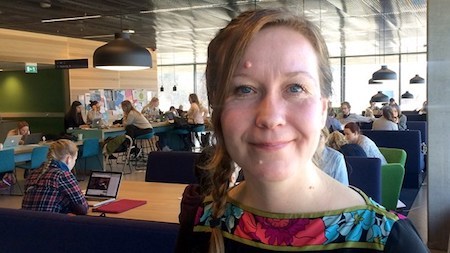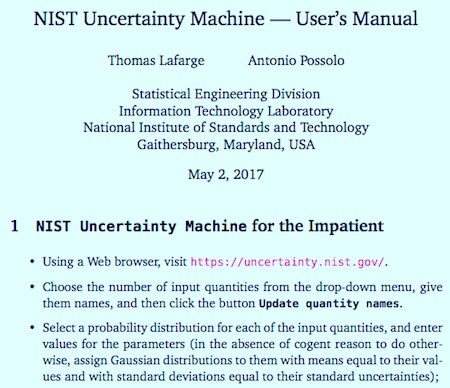Marc Abrahams's Blog, page 211
September 7, 2017
“All my colleagues are jealous of it”
” ‘The Ig Nobel is a respected award in academic circles. I think the Ig Nobel Prize is my biggest academic achievement and all my colleagues are jealous of it,’ says Minna Lyons, senior lecturer in psychology at the University of Liverpool and Finland’s only Ig Nobel Prize winner.” — [English translation from a September 1, 2017 article in Forum magazine called “Discoveries that made the world more fun“.]
Actually, there is at least one other Ig Nobel Prize winner from Finland.
Here’s a photo of Minna Lyons, on tour with other Ig Nobel Prize winners, in an event this past March at Stockholm University [click the image, and you can listen to an interview she gave to Sverige Radio]:

How do albatrosses fly around the world? (studies)
This is what Professor John Cleese (Cornell University) had to say about albatrosses in 1970 *
But Professor Cleese is by no means the only academic to have taken a keen interest in the enigmatic birds. Many have pondered the question of how wandering albatrosses spends weeks, even months, at sea without ever returning to land (in both senses of the word). Several research groups have attempted to provide answers – but there still isn’t complete agreement. Professor Philip L. Richardson of the Department of Physical Oceanography, Woods Hole Oceanographic Institution, for example, tends towards the ‘Gust Soaring’ model
“In gust soaring a bird exploits structures in the wind field, such as separated boundary layers and eddies in the lee of wave crests, to obtain energy by climbing headed upwind and descending headed downwind across a thin wind–shear layer.”
Source: How do albatrosses fly around the world without flapping their wings? Progress in Oceanography, 2010.
Then again, Gottfried Sachs, Johannes Traugott, Anna P. Nesterova, Giacomo Dell’Omo, Franz Kümmeth, Wolfgang Heidrich, Alexei L. Vyssotski and Francesco Bonadonna presented a key paper in PLOS | ONE, September 5, 2012, entitled ‘Flying at No Mechanical Energy Cost: Disclosing the Secret of Wandering Albatrosses’ with the observation that:
“the energy gain is achieved by a dynamic flight manoeuvre consisting of a continually repeated up-down curve with optimal adjustment to the wind.“
Despite the claim that the secret had been disclosed, a subsequent paper presented yet another viewpoint. Johannes Traugott, Anna Nesterova and Gottfried Sachs, writing in IEEE Spectrum, 2013, favoured the ‘Dynamic Soaring’ approach, in ‘The Nearly Effortless Flight of the Albatross’.
Back to Professor Richardson again : he’s now retired, but nonetheless is continuing to pursue the question – with the help of a robot albatross. See: Upwind dynamic soaring of albatrosses and UAV’s. in Progress in Oceanography, 130, 146-156. 2015.
* Note : To be precise, Professor Cleese was not a professor at the time of the recording – or indeed this one [poss. nsfw]. He was, however, fully invested for this one.

September 4, 2017
“Mind the [wildcard] gap” — in academic paper titles
If you’ve ever used The Tube (the underground railway system) in London, there’s a very good chance you’ll know about this announcement :
What’s perhaps less well known is the wealth (perhaps even the plethora) of academic papers which have taken advantage of the phrase in their titles. Here are but a few examples :
• Mind the (Intelligibility) Gap
• Mind the (Computational) Gap
• Mind the implementation gap?
• Mind the Gender Gap in Farmers’ Preferences for Weather-Index Insurance
• Mind the gap: or why humans aren’t just great apes
Also see: “It’s [wildcard] Jim, but not as we know it” — The Firm’s lyrics in academic paper titles

August 31, 2017
Fancy Upgrade Car Wheels and their Evolutionary Significance (study)
“Charles Darwin considered costly traits that could not be accounted for by survival advantage, such as peacock tails, problematic to his theory of evolution by natural selection. He later realized that these features conferred reproductive advantage in the acquisition of mating partners.”
 Could this peacock tail insight be applied to humans? Specifically male humans? More precisely to male humans who are students? To be exact, to male human students who buy expensive fancy wheels for their cars? So wondered Daniel J. Kruger (School of Public Health, University of Michigan) and Jessica S. Kruger (School of Population Health, University of Toledo) who performed the first experimental study (of its kind) to determine whether visually conspicuous vehicle modifications influence perceptions of male owner’s reproductive strategy and attractiveness.
Could this peacock tail insight be applied to humans? Specifically male humans? More precisely to male humans who are students? To be exact, to male human students who buy expensive fancy wheels for their cars? So wondered Daniel J. Kruger (School of Public Health, University of Michigan) and Jessica S. Kruger (School of Population Health, University of Toledo) who performed the first experimental study (of its kind) to determine whether visually conspicuous vehicle modifications influence perceptions of male owner’s reproductive strategy and attractiveness.
“Ethnically diverse undergraduates at a large public university in the Midwestern USA (N = 339, 53% female, M age = 19, SD age = 1) completed anonymous on-line surveys at their convenience.”
The results of the survey, which showed the students photos of cars with upgraded wheels, allowed conclusions to be drawn – and published in a Professional Article for EvoS : The Journal of the Evolutionary Studies Consortium 2016, NEEPS Special Issue pp. 1-12 and which can be read in full here : Visually conspicuous vehicle modifications influence perceptions of male owner’s reproductive strategy and attractiveness
Note: The photo shows the r8t12 wheel (gold brush finish) available from Radi8
“Radi8 Wheels was [sic] made for those who stand out of the crowd, for those who want to try something different. We devote passion into designing each wheel with its own unique personality. From the ‘Charming Jerk’ wheel to the ‘Mr Drama Queen’ gives your ride that personal touch.”

August 30, 2017
Preview: “The Incompetence Opera”
The 2017 Ig Nobel Prize ceremony will include the premiere of a new mini-opera: “The Incompetence Opera.”
It’s a musical encounter with the Peter Principle and the Dunning-Kruger Effect. It’s about how and why incompetent people rise to the top — and what that implies for everybody.
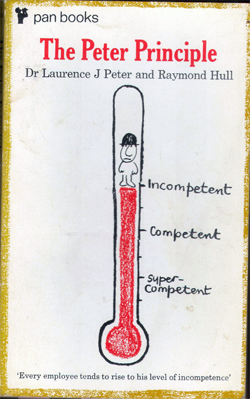 Music by Giacomo Antonio Domenico Michele Secondo Maria Puccini, John Walter Bratton, and Anon. Story and words by
Marc Abrahams
.
Music by Giacomo Antonio Domenico Michele Secondo Maria Puccini, John Walter Bratton, and Anon. Story and words by
Marc Abrahams
.Directed by Maria Ferrante and Robin Abrahams
Starring Maria Ferrante and Ray Bauwens
With The Peter Principle Chorus — Ellen Friend, Jan Hadland, Dakota McCoy, Anabel Graetz, Abby Schiff, Jean Cummings, Scott Taylor, Andrew Ross, Bjorn Corleis, John Jarcho, Ted Sharp, Michael Skersky, Daniel Rosenburg
Orchestral accompaniment by the Dunning-Kruger Effective Orchestra — Yulia Yun, Dr. Thomas Michel, and Dr. Bruce Koplan
The opera has three acts, which will intersperse with the awarding of this year’s ten new Ig Nobel Prizes, and with other goings-on. (The entire libretto is included in this year’s IgBill, the printed program distributed at the ceremony. You can download a copy now, in PDF form.)
WHEN AND WHERE: You can watch the opera premiere — and the entire Ig Nobel Prize ceremony — on the live webcast on Thursday evening, September 14. (A few tickets are still available, if you’d like to attend the ceremony at Sanders Theatre on the Harvard campus.)
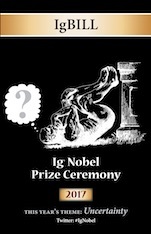 BACKGROUND (the principles and the prizes): The Peter Principle and the Dunning-Kruger Effect have each led to an Ig Nobel Prize.
BACKGROUND (the principles and the prizes): The Peter Principle and the Dunning-Kruger Effect have each led to an Ig Nobel Prize.
The 2010 Ig Nobel Prize for management was awarded to Alessandro Pluchino, Andrea Rapisarda, and Cesare Garofalo, for demonstrating mathematically that organizations would become more efficient if they promoted people at random. [Their research is described in “The Peter Principle Revisited: A Computational Study,” Physica A, vol. 389, no. 3, February 2010, pp. 467-72.]
The 2000 Ig Nobel Prize for psychology was awarded to David Dunning and Justin Kruger, for their modest report, “Unskilled and Unaware of It: How Difficulties in Recognizing One’s Own Incompetence Lead to Inflated Self-Assessments.” [Published in the Journal of Personality and Social Psychology, vol. 77, no. 6, December 1999, pp. 1121-34.]
BACKGROUND (the operas): Every Ig Nobel Prize Ceremony since 1996 has included a new mini-opera, performed by professional opera singers (with Nobel Laureates acting in supporting roles). These mini-operas honor the tradition of the classic Bugs Bunny cartoons “What’s Opera, Doc?” and “Rabbit of Seville“— each mini-opera is a pasticcio that marries a brand new story & words to beloved old music (from operas, popular songs, etc.). Here’s a list of the other Ig Nobel mini-operas:
2016: “The Last Second”
2015: “The Best Life”
2014: “What’s Eating You?”
2013: “The Blonsky Device”
2012: “The Intelligent Designer and The Universe”
2011: “Chemist in a Coffee Shop”
2010: “The Bacterial Opera”
2009: “The Big Bank Opera”
2008: “Redundancy, Again”
2007: “Chicken Versus Egg”
2006: “Inertia Makes The World Go Around”
2005: “The Count of Infinity”
2004: “The Atkins Diet Opera”
2003: “Atom and Eve”
2002: “The Jargon Opera”
2001: “The Wedding Complex”
2000: “The Brain Food Opera”
1999: “The Seedy Opera”
1998: “La Forza Del Duct Tape”
1997: “Il Kaboom Grosso”
1996: “Lament Del Cockroach”

August 29, 2017
Decisive-Regret-Under-Uncertainty Limerick Contest
This month’s research limerick contest:
Devise a pleasing limerick that encapsulates this study:
“Regret in Decision Making Under Uncertainty,” David E. Bell, Operations Research, vol. 30, no. 5, 1982, pp. 961-981. The author, at Harvard University, reports:
“After making a decision under uncertainty, a person may discover, on learning the relevant outcomes, that another alternative would have been preferable. This knowledge may impart a sense of loss, or regret.”
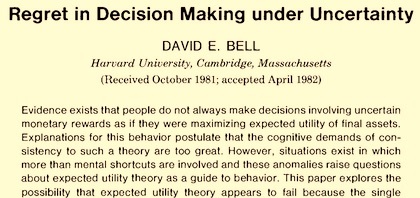
The contest, and details about how to submit your perfectly formed, delightfully enlightening limerick, are in the August issue of mini-AIR.

August 28, 2017
Sheep Also Yawn (contagiously)
The 2011 Ig Nobel Physiology Prize was shared by Anna Wilkinson (of the UK), Natalie Sebanz (of the Netherlands, Hungary, and Austria), Isabella Mandl (of Austria) and Ludwig Huber (of Austria) for their study ‘No Evidence of Contagious Yawning in the Red-Footed Tortoise.’ (published in Current Zoology, vol. 57, no. 4, 2011. pp. 477-84.)
Since then, research investigating Contagious Yawning in other species has not abated – two recent studies have added to the growing list* of animals which have been shown to contagiously yawn.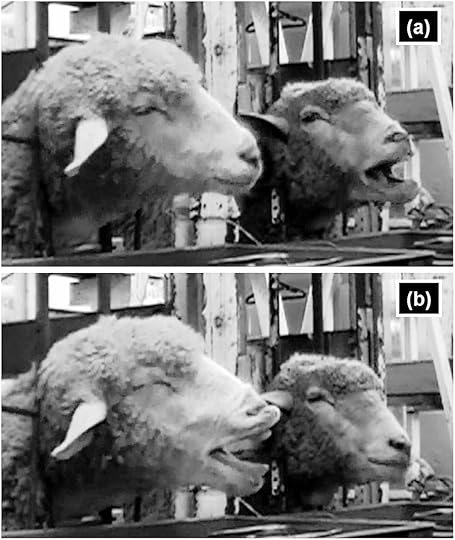
See: Presence of contagious yawning in sheep (2016)
and When Yawning Occurs in Elephants (2017)
* The current list includes (but is prob. not limited to)
Humans
Chimpanzees
Bonobos
Orangutans
Macaque monkeys
Gelada baboons
Wolves
Domestic dogs
Rats
Budgerigars
Sheep
Elephants

August 27, 2017
Estimated Insect Deaths Due to Collisions with Motor Vehicles
Building indirectly on Ig Nobel Prize-winning research, a 2015 study warns about the number of insects killed in collisions with cars, trucks, and other motor vehicles. The study is:
“Road mortality potentially responsible for billions of pollinating insect deaths annually,” James H. Baxter-Gilbert, Julia L. Riley, Christopher J. H. Neufeld, Jacqueline D. Litzgus, and David Lesbarrères, Journal of Insect Conservation, vol. 19, no. 5, October 2015, pp. 1029–1035. (Thanks to Hugh Henry for bringing this to our attention.) The authors, at Laurentian University, Canada, and Macquarie University, Australia, report:
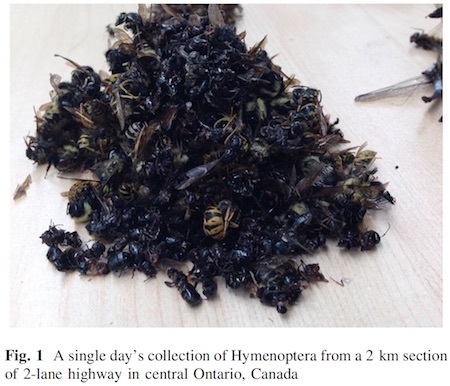
“Over the last few … numerous pollinating insect populations have declined substantially. The causes of these declines are multifaceted and synergistic, and include pesticides, herbicides, monoculture, urbanization, disease, parasites, and climate change. Here, we present evidence for a generally understudied yet potentially significant source of pollinator mortality, collisions with vehicles…. We documented road mortality of pollinating insects along a 2 km stretch of highway in Ontario, Canada and used our findings to extrapolate expected levels of road mortality across a number of landscape scales.”
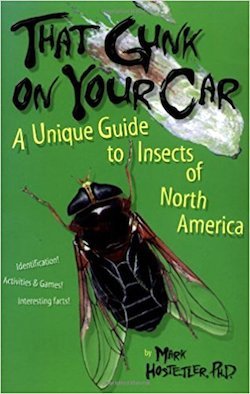 The 1997 Ig Nobel Prize for entomology was awarded to Mark Hostetler of the University of Florida, for his scholarly book, That Gunk on Your Car, which identifies the insect splats that appear on automobile windows.
The 1997 Ig Nobel Prize for entomology was awarded to Mark Hostetler of the University of Florida, for his scholarly book, That Gunk on Your Car, which identifies the insect splats that appear on automobile windows.
Sarah Knapton interprets the situation, in a report in The Telegraph, under the headline “‘The windscreen phenomenon’ – why your car is no longer covered in dead insects.”

August 24, 2017
Redefining Nonsense in English and Chinese (new study)
“Definitions of nonsense vary widely and often pay little attention to cultural context or the phenomenology of reading.”
– explains Professor Alan Levinovitz of James Madison University, US in a Sept. 2017 article for the journal Comparative Literature.
“After surveying the problems with these definitions, the article then redefines nonsense experientially, that is, as the experience, in time, of rewarding sense-juggling inspired by a semantically ambiguous text that resists conclusive interpretation. This new definition is explored and defended from a comparative perspective through an analysis of the difficulties inherent in the process of translating Lewis Carroll’s “Jabberwocky” from English into Chinese, using Chinese linguist Zhao Yuanren’s (趙元任) early twentieth-century translation as a case study.“
See : Slaying the Chinese Jabberwock: Toward a Comparative Philosophy of Nonsense in Comparative Literature, 2017 Volume 69, Number 3: 251-270.
BONUS [1]: A so-called ‘round trip translation’ of Lewis Carroll’s Jabberwocky from Through the Looking-Glass and What Alice Found There, 1872, transformed into (simplified) Chinese, and then back again into English, via the translation algorithms of a well known search engine *
There are swings and guitar in the giants:
All the maze are borogoves,
And, meow meow.
“Be careful Jabberwock, my son!
Bite the claws and claws to seize!
Be careful Jubjub bird, avoid
Cool Bandersnatch!“
He has a scorpion sword in his hand
For a long time he sought manxome enemies –
So rest him by the Tumtum tree,
And stood in thought for a moment.
And, like his Jewish thought, he stood there,
Jabberwock, with the eyes of the flame,
Came to the hut,
The buzzing of the buzzing
One two! One two! And through
Scorpion blade becomes powerful!
He put it dead, overhead
He went back.
“Did you kill Jabberwock?”
Came to my arms, my sparkling boy!
Lovely day! Callooh! Callay!”
He rejoiced.
There are swings and guitar in the giants:
All the maze are borogoves,
And, meow meow.
BONUS [2]: A video of a performance of Gerald Barry’s “Jabberwocky”

August 22, 2017
The Uncertainty Machine
NIST has an uncertainty machine. This theme of this year’s Ig Nobel Prize ceremony is UNCERTAINTY.
Make of these two facts what you will.
Does the uncertainty machine have a manual. Yes, it does.
(Thanks to Arno Laesecke for bringing the machine to our attention.)

Marc Abrahams's Blog
- Marc Abrahams's profile
- 14 followers


